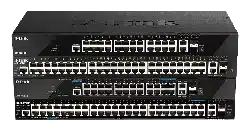Loading ...
Loading ...
Loading ...

DGS-1520 Series Gigabit Ethernet Smart Managed Switch Web UI Reference Guide
294
The fields that can be configured are described below:
Parameter Description
PIM State
Select to enable or disable the PIM state on this interface here.
Mode
Select the PIM mode here. Options to choose from are:
• Dense Mode - PIM-DM assumes that when a source starts sending, all
downstream routers wants to receive the multicast data stream. Initially
multicast data stream are flooded to all downstream routers and the
interfaces that have group members. If there are no downstream routers or
group members, the router will send prune message to indicate that the
multicast data stream is not desired.
• Sparse Mode - When multicast traffic is received on a sparse mode
interface, the first hop router will encapsulate and send the register
message to RP. If the router is not the first hop router, the traffic will be
forwarded based on the Multicast Route entry. A sparse mode interface will
only be populated as Multicast Route member interface if receive join
message from the downstream router or if group member on a sparse mode
interface, PIM join process will be triggered to create the shared tree or the
source tree.
• Sparse-Dense Mode - When interface is configured as PIM Sparse-Dense
mode, a multicast group received by the interface can operate in either
sparse mode or dense mode of operation. When the interface receives
multicast traffic, if there is a known RP for the group, then this group will
operate in sparse mode, otherwise this multicast group will operate in dense
mode.
PIM Passive
Select to enable or disable the PIM passive feature here. When the passive mode
is enabled, the interface will neither send PIM messages out nor accept PIM
messages from this interface. The router will act as if it is the only PIM router on
the network. Use this feature only when there is only one PIM router on the LAN.
Query Interval
Enter the interval at which hello messages are sent here. The range is from 1 to
18724 seconds. A PIMv2 router learns PIM neighbors via the PIM hello message.
This feature configures the frequency of the hello message. Routers configured for
IP multicasting send PIM hello messages to detect PIM routers. For SM, hello
messages also determine the router to act as the designated router for each LAN
segment. The configured query interval is also used as the value for hold time. By
configuring a smaller period for the interval, the unresponsive neighbor can be
discovered faster and thus the failover and recovery will become more efficient. By
default, this value is 30 seconds.
Select the Default option to use the default value.
DR Priority After selecting to use the Sparse Mode or the Sparse-Dense Mode, this
parameter will be available. Enter the Designated Router's (DR) priority value here.
The range is from 0 to 4294967295. A larger value represents the higher priority.
In the Dense Mode (DM), the DR priority option will not be carried in the hello
message. The router with the highest priority value will be the DR. If multiple
routers are with the same priority status, the router with the highest IP address will
be the DR. If there is a router that does not support the DR priority in its hello
message on the LAN, all routers on the LAN will ignore DR priority and only use IP
address to elect DR. By default, this value is 1.
Select the Default option to use the default value.
Join Prune Interval After selecting to use the Sparse Mode or the Sparse-Dense Mode, this
parameter will be available. Enter the Join/Prune message interval value here. The
range is from 1 to 18000 seconds. When configuring the Join/Prune interval,
consider the factors, such as the configured bandwidth and expected average
number of multicast route entries for the attached network or link. For the Sparse
Mode (SM), routers will periodically send join messages based on this interval. The
hold-time in a Join/Prune message is 3.5 times the join-prune-interval. The
receiving router will start a timer based on this hold-time, and prune the interface if
no join message was received on this interface. By default, this value is 60
seconds.
Select the Default option to use the default value.
Loading ...
Loading ...
Loading ...
